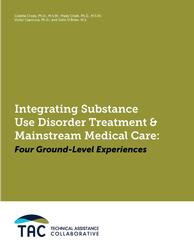NYS Conference of Local Mental Hygiene Directors, Inc. | An Affiliate of the New York State Association of Counties >
Hot Topics / Priority Issues
Integrating Substance Use Disorder Treatment and Mainstream Medical Care: Four Ground-Level Experiences
 In the course of just two generations, the delivery of medical care has evolved from small-group community practices to more corporately organized and specialized forms of care. During this same period, the treatment of substance use disorders (SUDs) has evolved from a marginalized social support service to a more broadly recognized specialty health service. This shift in SUD treatment has been propelled by neurobiological and social science research that firmly establishes SUDs as a treatable health condition. Yet even patients whose SUD is correctly diagnosed often experience missed connections and fragmentation in dealing with their overall health status.
In the course of just two generations, the delivery of medical care has evolved from small-group community practices to more corporately organized and specialized forms of care. During this same period, the treatment of substance use disorders (SUDs) has evolved from a marginalized social support service to a more broadly recognized specialty health service. This shift in SUD treatment has been propelled by neurobiological and social science research that firmly establishes SUDs as a treatable health condition. Yet even patients whose SUD is correctly diagnosed often experience missed connections and fragmentation in dealing with their overall health status.
“Integration” has become a health care buzzword used to describe a wide spectrum of approaches to remedying the fragmentation experienced by many patients. Integrated treatment, or addressing the ‘whole person’ in their social and cultural context, makes immense common sense — but the forces that organize the delivery, financing, training, and other aspects of health care too often push against this obvious logic, leaving patients frustrated with ‘the system.’ So what does it really mean to integrate SUD treatment and general medical care? What constitutes integration? Operationally, there are as many definitions as there are practical examples. All are based on recognizing the co-occurrence of substance use disorders with other conditions that determine health status.
This brief offers four examples of the integration of SUD treatment and mainstream medical care. Rather than searching for a uniform set of requisite traits, we decided to show why and how four very different groups of providers moved toward integrated care, asking, “What is the context in which integrated care occurred? Why did integrated care occur? How did it happen? Is integrated care better for the patient? Are there lessons to be learned from these experiences? What more should we know about integrated care?”



